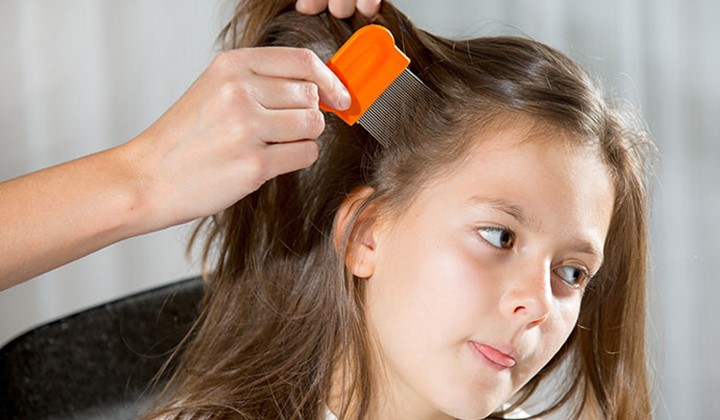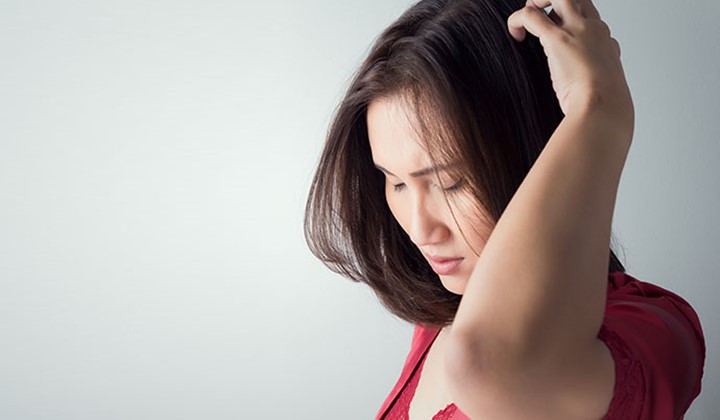It might look like dandruff – even if it’s not
Some skin diseases like dandruff and seborrheic dermatitis are mainly caused by the yeast-like fungus Malassezia furfur. These diseases should be treated with Nizoral®, a medicine that contains Ketoconazole 2%.
There are also diseases related to dandruff, with similar symptoms. Among others, these include:
Sunburn, Head lice infestation, Atopic dermatitis (neurodermatitis) & Psoriasis.

Did you get too much sun?
Never go to the beach, for a hike in the mountains or even just into town to get ice cream without wearing sunscreen. Avoid the midday sun. Wear a hat and suitable clothing to limit your body’s exposure to sunlight. In spring, take your time getting used to the sun again. All of this is common sense. Still, sunburns occur way too frequently. The sun’s ultraviolet rays can damage our skin. The result looks like an actual burn: red, flushed, itchy. In the worst cases, pain and blistering can also occur.
After a few days, the skin peels in the typical silvery-white, flaky manner. However, these skin flakes are not actually dandruff. The damaged skin recovers and repairs itself, while shedding the damaged skin cells.

Next time you go into the sun, remember to:
-
![]()
wear enough sunscreen
-
![]()
bring suitable sun protection for your head
-
![]()
wear suitable clothing
-
![]()
avoid the midday sun
-
![]()
give your body time to gradually adapt to the intensity of the sun

Eew, lice!
With children attending kindergarten or school, it is only a matter of time until the topic of “head lice” comes up. Some are fortunate enough to be spared from an infection. Others contract lice on a regular basis and spread them among family members. The reason why remains unclear. Lice have always lived among humans and have nothing to do with personal hygiene. Shame and reproach are thus uncalled for.
Once fully grown, lice crawl from head to head. Children’s hair strands provide the perfect mode of transmission – especially if they are playing side by side. Lice might also wait on pillows for their next "accommodation".
Female lice stick their eggs onto individual strands of hair near the scalp. When the next generation of lice hatches, their empty egg shells (nits) are left behind. These brownish-grey eggshells may look like dandruff.
Where there is one louse, there are others - usually on other people’s heads. In case of a suspected lice infestation, quick action is key: the environment (kindergarten, school, circle of friends) should be notified immediately. This way, other parents or friends can act quickly. Approved lice remedies help stop the infestation quickly and effectively.

Atopic dermatitis often “rights itself”
Cases of atopic dermatitis (neurodermatitis) have increased rapidly in recent years. Nowadays, it is one of the most common childhood diseases. Neurodermatitis is not contagious. It is however chronic (= permanent) or recurring. Researchers cannot yet pinpoint the causes of atopic dermatitis. They suspect an interplay of genetic conditions, immunological changes and environmental influences.
In atopic dermatitis, the visible part of our skin, the stratum corneum (Latin for 'horny layer'), cannot properly fulfill its protective barrier function. Inflammatory reactions are damaging the skin. A possible cause: a deficiency of a particular protein (filaggrin) that is crucial for balancing the moisture levels of the skin. Damaged, dry skin is also unable to protect from irritants or allergenic substances.
Skin with areas of atopic dermatitis is sensitive, dry and often reddened. Sufferers often feel extremely itchy. The scratching that ensues further destroys the skin. The inflamed skin thickens and flakes.
How long do people usually suffer from atopic dermatitis? It largely depends on when one got sick as a child. In children who experience systems within their first year of life, the disease usually comes to a halt after three years. Eight in ten children who experience systems at the ages of two to five are asymptomatic after ten years. Adults rarely have atopic dermatitis, but if they do, it is more severe than in children.

Psoriasis: An impairment for body and soul
As with psoriasis, those affected often suffer in manifold ways. Not only can the itching be agonizing, especially at night, and thus cause sleep deprivation, the disease can be a psychological burden as well. Many people with eczema are ashamed of the appearance of their skin. A capable pediatrician or dermatologist can provide patients with suitable treatment options and information.
First of all, psoriasis (psoriasis vulgaris) is not contagious. It is a primarily genetic (hereditary) condition. As of yet, there are no conclusive results as to what causes the disease.
Keratin-forming skin cells, so-called keratinocytes, form our protective epidermis. They divide several times and usually shed after four weeks. With psoriasis, the cell division happens much faster. The dead skin cells cannot keep up with the rate at which new ones form. The trigger is an autoimmune reaction that is often accompanied by an inflammation of the skin. The symptoms include reddened, thickened lesions of the skin. They can be extremely itchy and have a silvery, scaly appearance. The disease progresses in phases, so it keeps flaring up.

People with psoriasis often suffer from simultaneous psychological problems: the disease does not only cause itching and discomfort. Those affected regularly experience rejection and exclusion in everyday life, because they are visibly marked by their condition. The necessary, extensive skin care routine takes time – a rare commodity in everyday life. Moreover, psoriasis is not just a skin disorder. It can also spread to joints and organs.
If you think you might suffer from psoriasis, contact a dermatologist. He can accurately diagnose the disease, prescribe suitable medication and give advice on necessary care and additional support.








